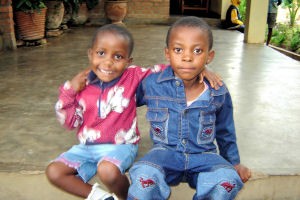Child Sponsorship Background from Kigali, Rwanda
 SOS Children's Village Kigali
SOS Children's Village Kigali
SOS Children's Village Kigali was built on a hill, about 10 km from the
city and has been open since December 1979. It has 15 family houses for a
total of 150 children, an administration building, a village director's
house, an aunt's house and a service area with a canteen.
Other SOS Projects in Kigali
So as to encourage young people who are reaching adulthood to become more independent, an SOS Youth Home was opened in 1986. It consists of four youth houses, in two of which girls live (each containing seven rooms, a lounge and a kitchen). The other two, in which boys live, consist of four small houses that each have two rooms. Life in the SOS Youth Facilities requires the young people to take increasing personal responsibility, especially since they are only supervised by a caregiver there. They stay in the SOS Youth Home for about four years, but young people who are still in education or are looking for work can stay for longer.
In the years that followed, additional facilities were added to the Kigali site, which also holds many advantages for the people from neighbouring areas:
The Village's SOS Nursery School has existed since 1981 and is attended by 80 children who also come from the neighbouring areas. Three group rooms and different adjacent rooms are also available for the small children, as well as a playground which gives them plenty of opportunity to play on climbing frames, swings and slides and to run around.
Since October 1997, 630 children have been taught in 18 classes at the SOS School (Primary School). They are also allowed to use special classrooms. The school became an important centre for the whole area and makes it possible for children to be educated to an advanced level.
After the civil war had brought endless sorrow to the whole of Rwanda and since even prior to it health care had been inadequate, SOS Children's Villages decided to create an SOS Medical Centre that has been available for the people to use since March 1998 (about 3,800 patients per year). The clinic consists of two treatment rooms, two laboratories and a health education room so as to give people as great an understanding as possible as to how their body functions.
To give SOS mothers and SOS staff the opportunity to receive further education, an SOS Vocational Training Centre was opened in Kigali at the end of 2000, which is currently used by around 150 mothers and employees, who can also stay in the 23 rooms. Teaching takes place in two classrooms and a library, workshop, canteen, store and the appropriate sanitary facilities are also available.
Background to Kigali
Kigali has a population of more than 850,000 and is the capital and largest city of Rwanda, central Africa. The country was under German colonial rule until 1962, and since independence Kigali has been an economic, cultural, and transport hub. The city is built in hilly country, sprawling across about four ridges and the valleys in between, with some of the elevations reaching 1,300m.
April 1994 saw the start of the Rwandan Genocide. Although damaged during the atrocity, the city's structure has recovered and centres dedicated to the Rwandan Genocide include the Kigali Genocide Memorial Centre as well as other memorials and museums.

 Return to Schools Wikipedia Home page…
Return to Schools Wikipedia Home page…
